The question in the title is motivated by discussions I had recently on some social media forums and groups. My impression is that people tend to use the term “too crowded” in a superficial manner, without really specifying the meaning of the phrase, and without understanding the topic completely.
I have asked a few times what they mean by “crowded”, and how/why the crowd is a problem, and as a rule, I never get a proper answer. This is why I thought this issue should be discussed in a separate post, and here it is.
Alta Via huts are typically fully booked in a hiking season, but this corresponds to their capacity. So, they cannot be described as crowded simply because they will rarely admit more than the number of beds they have.
On the other hand, in full season some particular trekking sections and places on Alta Via routes may have an increased number of day visitors and tourists from nearby valleys. But this has nothing to do with true multi-day trekkers that are on an Alta Via route.
In any case, crowd on Alta Via sections is never such that you should be worried about it.
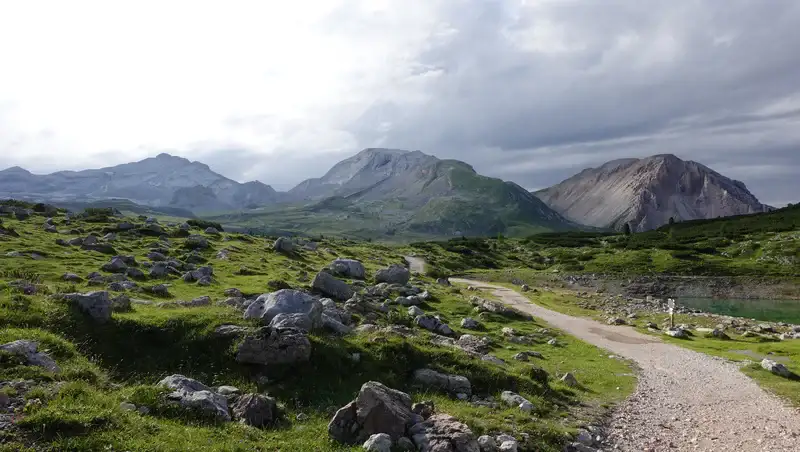
To understand terminology first: what you have on an Alta Via route
There are 10 Alta Via routes in the Dolomites, and on all of them you will have the following:
- Huts.
- High elevation restaurants (malgas, etc.).
- Trail sections between huts.
- Attractive tourist spots.
In addition, on some of them you may have ferrata passages, and if there are many people, you might be forced to wait.
So, in principle, the term “too crowded” applies to each of these elements, but separately and differently as you will realize below.
Alta Via huts, crowded or not?
Huts are hubs where people naturally converge in this environment. This holds not only for the hikers on an Alta Via route, but also for locals and tourists that hike to the huts from the surrounding valleys.
So there is no doubt they may be full of people during the day. Many of these huts are more high elevation restaurants and mountain hotels than real huts, so you will see chairs and tables outside and they will be full of people.
But regarding accommodation, huts have certain capacities, and those on the Alta Via routes are typically always fully booked, with little difference between any week in official summer months.
Therefore, huts are not crowded, they may just be fully booked. So if you have no reservation, you will not be there in any case and you will not be able to experience them as “crowded”. There is nothing to avoid, as some suggest. You see the point?
Regarding restaurants that you may have on some sections, they are typically always crowded but you will always be served, this is sure, so I would never be worried about them.
Crowded sections between huts?
I have seen some suggesting to avoid Alta Via routes in particular in August because of too many people. However, as I mentioned above, there is little difference between August and other snow-free months in the Dolomites.
Namely, assuming that most of hikers on the AV routes will indeed be accommodated in the huts, the number of people on a section of an Alta Via route, coming every morning from these huts, will not be much different, regardless of the month.
Huts can only accommodate a certain maximum number of trekkers. Now, when in the morning people from huts continue their journey and spread over kilometers long sections, there is little chance to have an overcrowded section.
Though, there is a bit more to this, trekkers on sections are not necessarily only those that walk a full AV route, more farther in the text.
But see the picture below, there are no less than four huts above the pass, and all of them accommodate AV1 trekkers.
You would expect a line of hikers moving here, right? Well, there was literally nobody descending from the huts, and this was high season. Too early in the morning? Perhaps it is so, this could be one possible explanation.
But I have been there a few times and in different intervals during a day, and I have never seen a crowd due to AV1 trekkers.
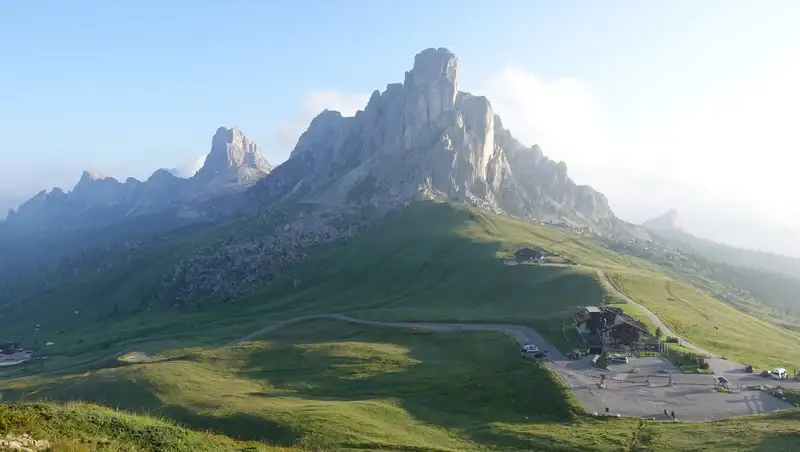
This place becomes crowded and you will see many cars parked along the road to the pass. This is due to vicinity of Cinque Torri and the beauty of the pass itself, so tourists come here and make a round tour.
I did the round tour myself and I didn’t feel that the route was crowded. I was alone all the time, nobody was walking anywhere close behind me, but I have met a few groups going in the opposite direction.
Attractive tourist spots
I would say this is the biggest issue here, and this is why so many people wrongly speak about crowd on Alta Via routes.
The reality is that this is because of tourists that visit such popular places from nearby valleys or passes, and due to locals that also go there.
The mentioned Cinque Torri is one of such places. Yet another is lake Sorapis, it is on two Alta Via routes, but this is nothing compared to the crowd that goes there daily from Tre Croci pass.
But I do not see any reason why this should be a problem for a trekker on an Alta Via route. Nevertheless, there are ways to manage this, more below.
How to define “too crowded” when this is only about route sections, not the crowd in huts?
Defining “too crowded” for the trail sections of the Alta Via routes in the Dolomites, without considering hut accommodations, would involve several subjective and objective criteria:
Objective measures
Number of hikers: Imagine that sections of the trail have one hiker per meter, or you can see a continuous line of hikers ahead and behind you. This should certainly be considered too crowded by most standards.
I have seen the phrase “bumper-to-bumper” used to describe crowd, but this is never so on Alta Via routes.
Let’s see the numbers from a different angle. Assume 100 people sleeping in a hut, and then next morning they walk on a 10 km section in average groups of 3 or 5. This could make the average distance of 300 and 500 meters between them. So if you go solo, you will have plenty of options for hiking in solitude.
Passing frequency: If you’re unable to hike more than a few minutes without having to step aside to let others pass or being passed yourself, it indicates a high traffic.
Once, I was taking a long rest at Lago Coldai and the AV1 route was just meters away, see the picture. It was mid-day and this is a popular spot, but just a few people walked along the path, although this was the last weak of July. Nobody can describe this as a high traffic.
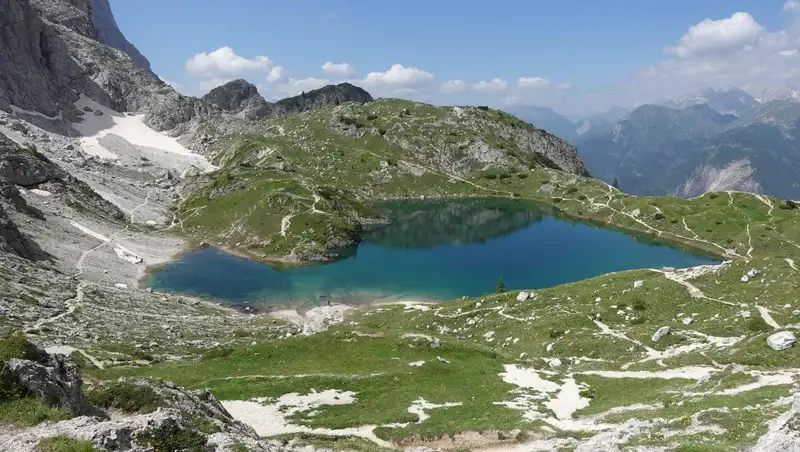
Time to traverse: An unusually long time to cover a known distance due to the need to wait or slow down for other hikers.
Trail wear: Visible signs of heavy use, like significantly widened paths or erosion, can also indicate that a section is experiencing too much traffic for its capacity.
Well, this holds for many areas on Alta Via routes, but wide paths are due to day-hikers and tourists from valleys, and not from multi-day trekkers. Tre Cime below is one obvious example, this is a part of Alta Via 4, but it is also an enormously popular tourist spot.
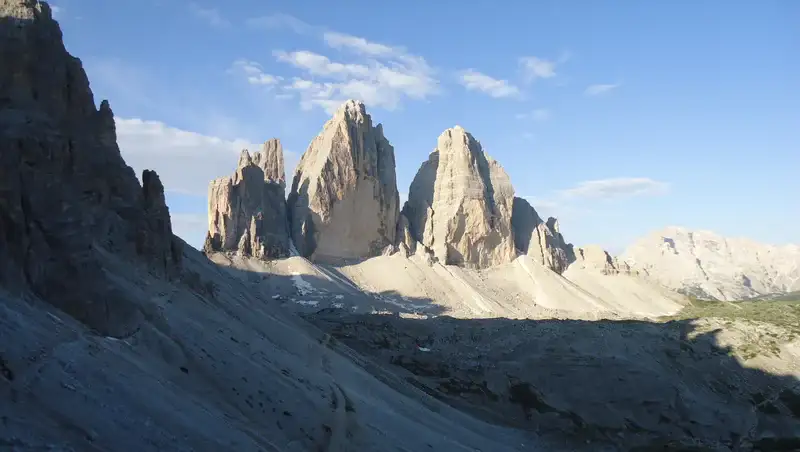
Subjective experiences
Loss of solitude: If the primary reason for hiking is to enjoy solitude or nature in a more personal way, encountering numerous hikers might feel like “too crowded.”
Noise levels: If the natural sounds of the Dolomites are frequently interrupted by human voices, laughter, or equipment noise, this could detract from the hiking experience.
Photography: For those who hike to capture the beauty of the landscape, having to wait for clear shots or constantly photobombing others might define “too crowded.”
From my own experience, this may happen at huts or on mountain summits, but practically never on these routes.
Hiking style: For those who prefer a brisk pace or a more meditative slow hike, crowded conditions where you must adjust your speed or rhythm constantly might feel overwhelming.
Safety concerns: If the crowd affects safety, like on narrow ledges or during ascents/descents where a steady pace is crucial, then the crowd level might be considered “too crowded.”
But look at the picture below, this is below Lago Sorapis, and this is officially on Alta Via 3, and also on Alta Via 4. There were hundreds of hikers here visiting this popular lake, but as you see there was nobody when I was taking the picture on these narrow passages.
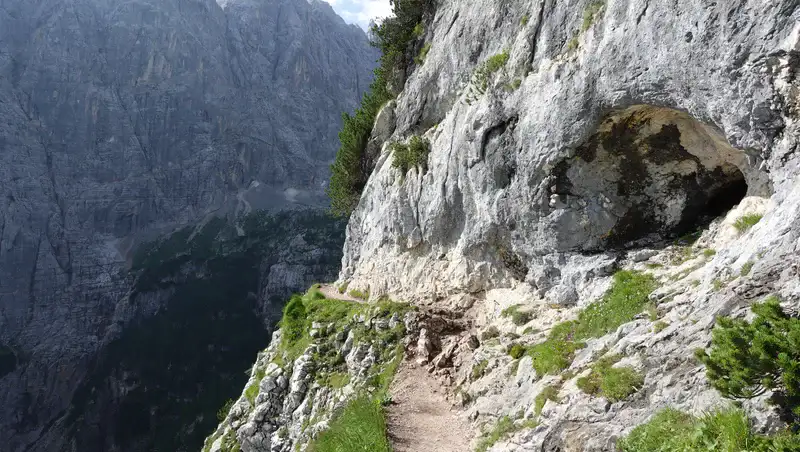
Practical considerations
Route sections: Certain parts of the Alta Via, like the approach to famous viewpoints or after trailheads near popular towns, might naturally see more traffic. Here, “too crowded” could be when the trail feels like a queue rather than a path.
But even on the incredibly popular place like Sorapis (a more popular place you can hardly find in the Dolomites), there is never a real queue.
Time of day: Early morning or late afternoon might see less crowding, whereas mid-day, when many start or finish their daily hike, could feel more packed.
Below you can see such a moment, a lonely AV1 trekker on the path from Gran Fanes to Lagazuoi. This is the heaviest part of the route where you walk to the highest point on AV1.
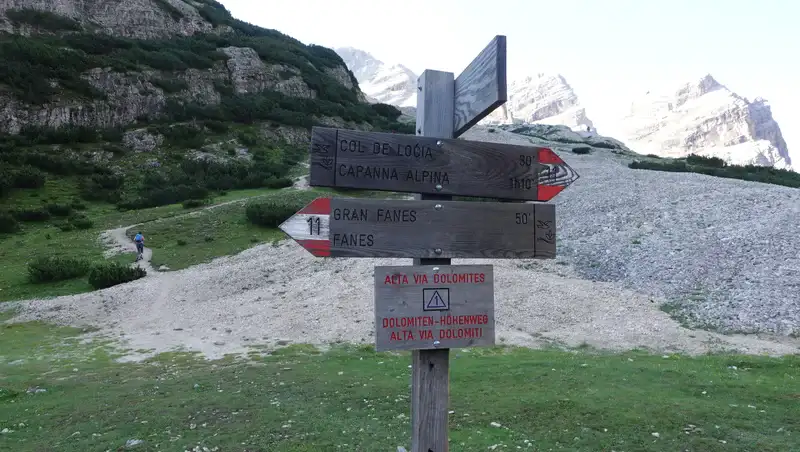
In essence, “too crowded” on these trails would be where the experience of hiking is significantly altered from what one might expect or desire in terms of peace, safety, pace, and interaction with nature.
This threshold varies greatly from one hiker to another based on their expectations, experience, and personal tolerance for crowds.
But are Alta Via routes in the Dolomites really ever too crowded?
This question touches on several aspects of hiking and travel in one of Italy’s most scenic regions. Here’s a detailed answer.
Seasonal crowding
Peak season (July – August): During the high summer season, the Alta Via routes can become significantly crowded. This is when many people, including international tourists, take their holidays.
The weather is generally good for hiking, but this popularity leads to crowded trails, especially on weekends. But this is not necessarily only due to hikers that are on an Alta Via route. In fact, this is more due to people who go into mountains from surrounding valleys and popular tourist resorts in the Dolomites.
However, see the picture below, this is Gran Fanes on AV1 in top season and relatively early in the morning. There was nobody around.
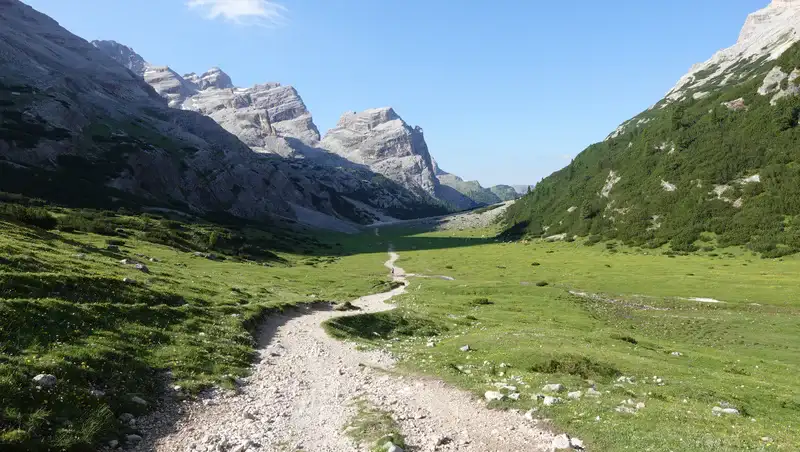
Shoulder seasons (June, early September): These months see fewer crowds from the valleys in the Dolomites, offering a more peaceful hiking experience for Alta Via trekkers.
Off-Peak (Late September to May): Snow can make many sections of the Alta Via routes inaccessible or dangerous without proper equipment. But most huts will be closed, so this season is not suitable for Alta Via tours.
I know that some people do the tours with tents, but strictly speaking this is against rules, read more in my separate text.
Specific routes
Alta Via 1 (AV1): This is probably the most popular route, especially from Lago di Braies to Cortina d’Ampezzo.
Here, crowding is most noticeable near well-known access points and during peak times. In particular, this holds for Lagazuoi area, Passo Giau, Gran Fanes. In other words, this is not about the AV1 route hikers.
Alta Via 2 (AV2): Generally less crowded than AV1 as it’s less known and involves more challenging terrain. Still, during peak season, you’ll meet more hikers than in shoulder seasons.
Other Alta Vie: There are several more other Alta Via routes (AV3 to AV10), which see even less traffic, providing more solitude even in peak season.
Factors influencing crowds
Hut accommodations: The huts (rifugi) along the routes must be fully booked in advance during peak times, which practically limits crowd levels. It is determined by the numbers of beds in huts.
Day hikers vs. multi-day trekkers: Day sections close to roads or popular spots like Lago di Braies can be packed with day hikers, contrasting with the quieter multi-day segments further from civilization.
Day hikers are the main reason why so many people claim that the AV routes are crowded. In fact true multi-day trekkers are typically a minority in the crowd.
The picture below shows a part of Alta Via 2, Piz Boe is above. It was empty when I was there, but there is a cable car from Pordoi pass, so the area may see many visitors. But even this area cannot be described as over-crowded.
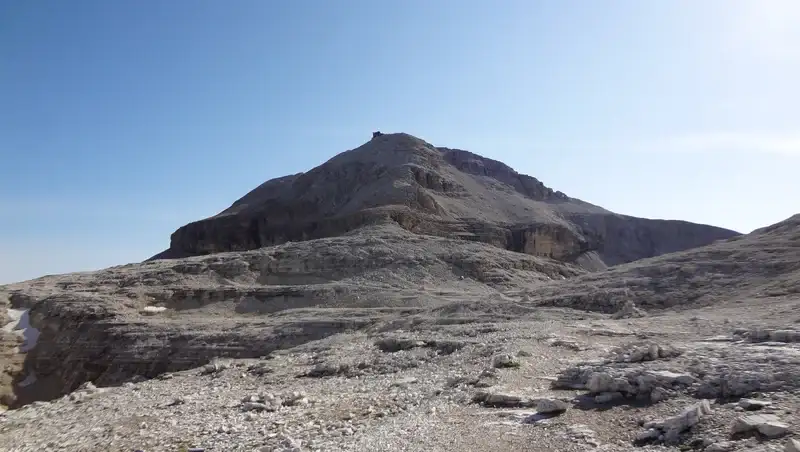
Social media and tourism: With the rise of social media, certain spots have become Instagram famous, drawing more crowds to specific segments of the routes.
Go to Facebook and search for Dolomites group and you will realize this. A huge majority of people there are interested in just a few most famous tourist attractions.
Managing crowds
Early starts: Starting your hike early in the morning can help avoid crowds, especially on popular segments. But bear in mind that many sleeping in the same hut will possibly think the same way…
Alternative paths: Some routes have lesser-known variants or detours that can provide a quieter experience.
Mid-week hiking: If possible, organize your hike in such a way that you are in the most popular sections during the week rather than weekends.
Final thoughts
In conclusion, some particular and popular areas and spots on the Alta Via routes in the Dolomites can indeed be crowded at times, particularly during peak tourist seasons.
But it is important i) to understand what the word “crowded” really means, and, ii) realize that this is not due to true Alta Via multi-day trekkers. In fact, this is practically always due to day hikers and tourists that have nothing to do with Alta Via routes.
When you hear people complaining about crowd, those are likely not Alta Via trekkers but tourists that have problems finding a parking when they want to visit popular tourist spots in the Dolomites.
There are strategies to avoid crowd, like choosing the right time of year, route, or even timing your hikes.
However, the beauty and appeal of these trails mean they will always attract visitors, and part of the hiking experience might include sharing these breathtaking landscapes with others. From some source I read that 34 million of people visited the area in 2023.
Just to add that it has never been my habit to complain about crowd in the mountains. Normally, I go to more desolate areas and to summits, and on some of such tours I sometimes see nobody.
In fact, when you are alone in such an environment, you realize that hearing human voices and seeing people makes you feel safer.
Now, if you think that I am talking nonsense in this text, tell me this in the comment section bellow. Just to know, I have heard this already in some of forums, so I am used to it. You might want to read also my separate text about hiking in the Dolomites and related FAQs.
Thank you for reading. Please join us at our Facebook group Dolomites Visitors Hub.
Subscribe to our weekly newsletter, this will keep you informed because I add texts here regularly. Have a nice day.
Leave a Reply